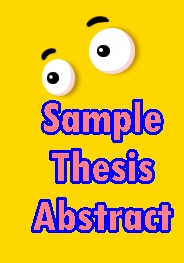 TITLE PAGE
TITLE PAGE
- This page is assigned a Roman numeral “i” although does not appear on the page
- The date used is the month and year of commencement
- The proponents name must appear as registered at the institution
APPROVAL PAGE
- The names used on the approval sheet and title page must be that under which the proponents are registered at the institution
- Black ink is required for the signatures of approving signatories
- The number of signature lines must equal to the number of panelists
- The approval page required counted as page “ii” but not numbered
ACKNOWLEDGMENT
- Numbered with Roman numeral “iii”
ABSTRACT
- Number page; Roman numeral and placed at center of heading
- Should be a concise review of the work containing a brief summary of the problem and results of the research.
- A short statement concerning the area of research study
- A brief discussion of methods and procedures used in gathering data
- A condensed summary of the findings and conclusions reached in the study
CONTENT OF ABSTRACT
- Proponents
- Title
- Key concepts
- Degree
- Adviser/s
- Statement of the Purpose or Problem
- Methodology [ Research Design and Procedure]
- Summary of Findings
- Recommendations
TABLE OF CONTENTS
Acknowledgment
Abstract
Table of Contents
List of Tables, Charts, Figures, Plates
Chapters [with Chapter I starts as page 1
Bibliography
Appendices – include Gantt Chart of Timetable
Curriculum Vitae
TYPE FONTS and PRINT QUALITY
1. Recommended font – Times Roman, size 12
2. Line Spacing – standard double space
3. Margins – the left hand margin must be 1½ inches wide to allow for binding; all other margins must be 1 inch wide. Adherence to this margin will leave a 6×9 inch area on each sheet of the text or illustrative material including page numbers. The right margins should not be justified. The only exceptions to the margin requirements are:
a) The first page of each chapter or major section of the manuscript, where typing begins 2” down from the top rather than 1” and tables and figures maybe smaller and centered but not larger than the 6×9 area.
b) Tables and figures must be reduced to meet margin requirements
c) It is not permissible to leave a single line of a paragraph or other subdivision at either the bottom or top of a page.
d) The last word on a page cannot be hyphenated.
4. Pagination
a) Every page of the thesis must have a page number except the title page, approval page, abstract pages and CV.
b) Small roman numerals (ii, iii,etc) are used for the preliminary pages: acknowledgement, table of contents and list of tables
c) Arabic numbers are used for the remainder of the document including the text and reference material. No other numbering scheme is acceptable.
d) All page numbers must be placed 1” from the top, even with the right margin
e) On pages with a major heading such as APPENDIX or BIBLIOGRAPHY and those beginning a CHAPTER, the page is placed in the center bottom position – 1” up from bottom
f) Numbers of preliminary pages are placed at the center bottom in small roman numerals.
 The primary purpose of this study is to explore the development of a solar dehydrator for the use of the indigenous people and other partner communities of the University of Santo Tomas’ in the rural areas. The research study focuses in the design and adaptability of the solar dehydrator to the produce of these partner communities as way to alleviate their plight of poverty due to exploitation of tradesmen buying their agricultural output such as papayas, bananas, mangoes, root crops, ginger, etc.
The primary purpose of this study is to explore the development of a solar dehydrator for the use of the indigenous people and other partner communities of the University of Santo Tomas’ in the rural areas. The research study focuses in the design and adaptability of the solar dehydrator to the produce of these partner communities as way to alleviate their plight of poverty due to exploitation of tradesmen buying their agricultural output such as papayas, bananas, mangoes, root crops, ginger, etc. TITLE PAGE
TITLE PAGE